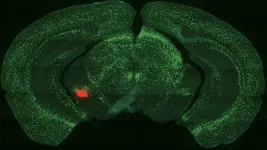(Press-News.org) Researchers at Simon Fraser University are studying the genes of superbugs to aid the development of new and effective treatments for drug-resistant bacterial infections. Superbugs are characterized as infection-causing bacteria resistant to treatment with antibiotics.
“Antimicrobial resistance occurs when the disease-causing bacteria has ways to overcome the antibiotics that we use in treatment for infections,” says assistant professor Amy Lee, of SFU's Department of Molecular Biology and Biochemistry. The initiative is a collaboration between the Lee Lab and Brinkman Lab, which are working together as part of the interdisciplinary SFU Omics Data Science Initiative (OSDI). “Our lab tries to understand how bacteria develop resistance because that makes the drug ineffective,” says Lee.
Their review of work to identify pathogen-associated genes in various disease-causing bacteria and develop new antivirulence drug treatments has been published in eBioMedicine, part of The Lancet’s Discovery Science.
Antibiotic or antimicrobial resistance has been named a top global health threat by the World Health Organization (WHO).
“The ultimate goal of our research is to use current sequencing technologies and computational analysis to discover new drug targets, which can be used to develop new drugs to fight bacterial infections,” says SFU alumnus Venus Lau, the study’s lead author.
The team applied bioinformatics, using SFU’s Big Data Hub, to perform a computational analysis of thousands of bacterial genomes from Escherichia coli to Vibrio cholerae.
“The one bacteria species I was most interested in was Pseudomonas aeruginosa,” says Lau. “It is known to be naturally resistant to drugs based on their cell membranes.”
“Drugs don't get into this bacterium easily and they tend to acquire other resistance mechanisms over time. It’s a difficult bug to treat.”
The bacterial species P. aeruginosa can cause infections in the blood, lungs (pneumonia) or other parts of the body, particularly in those who are ill or recovering from surgery in hospital.
Lau notes that some of the genes the team discovered through analyzing various disease-causing bacteria had not been previously characterized. “Part of our research was to figure out what these genes do and how they’re responsible for causing disease and infection symptoms in humans.”
Antivirulence over antibiotics to treat bacterial infections
An alternative approach to treating bacterial infections with antibiotics to overcome the issue of drug resistance involves antivirulence drugs.
New antivirulence therapies work to ‘disarm’ or inhibit the ability of the bacteria to cause disease without causing resistance to develop. In contrast, antibiotics kill bacteria, which essentially encourages the bacteria to ‘fight back’ by developing drug resistance.
“Antibiotics wipe out bacteria leading to a process of natural selection where those few surviving bacteria in the population will then repopulate,” says SFU molecular biology and biochemistry postdoctoral fellow Patrick Taylor. “The bacteria that are not killed off are really good at sharing their genetics with each other, which is why we have this rising global issue of antibiotic resistance.”
Antibiotics also eliminate non-disease-causing gut microbiota, or the ‘good bacteria’ that exists in the human body, which can have additional negative health impacts.
Taylor says antivirulence therapeutics can mitigate disease and reduce the burden on the healthcare system by reducing the bacteria’s ability to cause damage to the host, which provides time for the person’s immune system to clear the pathogen.
Continued work towards developing antivirulence drugs is needed as the WHO estimates that antimicrobial-related infections currently account for over 700,000 annual deaths and are projected to reach 10 million annual deaths by 2050.
END
SFU research aids fight against treatment-resistant superbugs
2023-04-05
ELSE PRESS RELEASES FROM THIS DATE:
Underground water could be the solution to green heating and cooling
2023-04-05
About 12% of the total global energy demand comes from heating and cooling homes and businesses. A new study suggests that using underground water to maintain comfortable temperatures could reduce consumption of natural gas and electricity in this sector by 40% in the U.S. The approach, called aquifer thermal energy storage (ATES), could also help prevent blackouts caused by high power demand during extreme weather events.
“We need storage to absorb the fluctuating energy from solar and wind, and most people are interested in batteries ...
WVU researchers earn $8M for rare earth extraction facility, an economic and environmental game changer
2023-04-05
West Virginia University researchers will continue to develop and advance their pioneering method to extract and separate rare earth elements and critical minerals from acid mine drainage and coal waste, courtesy of $8 million in new funding from the U.S. Department of Energy.
The grant, part of President Joe Biden’s Investing in America agenda, will lead to the design, construction and operation of a pre-commercial demonstration facility for separating and refining rare earth elements and critical minerals, according to Paul Ziemkiewicz, project lead and director of the West Virginia Water ...
Danger or pleasure? How we learn to tell the difference
2023-04-05
Deep within our brain’s temporal lobes, two almond-shaped cell masses help keep us alive. This tiny region, called the amygdala, assists with a variety of brain activities. It helps us learn and remember. It triggers our fight-or-flight response. It even promotes the release of a feel-good chemical called dopamine. Scientists have learned all this by studying the amygdala over hundreds of years. But we still haven’t reached a full understanding of how these processes work.
Now, Cold Spring Harbor Laboratory neuroscientist Bo Li has brought us several important steps closer. His lab recently made a series of discoveries ...
Ice sheets can collapse faster than previously thought possible
2023-04-05
Ice sheets can retreat up to 600 metres a day during periods of climate warming, 20 times faster than the highest rate of retreat previously measured.
An international team of researchers, led by Dr Christine Batchelor of Newcastle University, UK, used high-resolution imagery of the seafloor to reveal just how quickly a former ice sheet that extended from Norway retreated at the end of the last Ice Age, about 20,000 years ago.
The team, which also included researchers from the universities of Cambridge and Loughborough in the UK and the Geological Survey of Norway, mapped more than 7,600 small-scale landforms called ‘corrugation ridges’ across the seafloor. The ridges ...
Chinese researchers achieve superionic hydride ion conduction at ambient temperatures
2023-04-05
Materials that can conduct negatively charged hydrogen atoms in ambient conditions would pave the way for advanced clean energy storage and electrochemical conversion technologies. A research team from the Dalian Institute of Chemical Physics (DICP) of the Chinese Academy of Sciences (CAS) demonstrated a technique that enables a room-temperature all-solid-state hydride cell by introducing and exploiting defects in the lattice structure of rare earth hydrides.
Their study was published in Nature on April 5.
Solid materials ...
Therapy for babies with signs of autism cuts long-term disability costs
2023-04-05
New research evaluating the potential cost savings of a therapy for babies displaying early autism signs has predicted a three dollar return to Australia’s National Disability Insurance Scheme (NDIS) for every dollar invested in therapy.
Published in the prestigious JAMA Network Open, the health economic study drew on the results of a landmark multi-centre randomised clinical trial which reported the world’s first evidence that a therapy commenced in infancy (iBASIS-VIPP)* could reduce early developmental disability to the point where a childhood clinical autism diagnosis was two-thirds ...
CHOP researchers reveal complex assembly process involved in DNA virus replication
2023-04-05
Philadelphia, April 5, 2023—In a twist on the question, “Which came first, the chicken or the egg?”, scientists have long faced a similar question about how human adenovirus replicates: “Which comes first, assembly of the viral particle, or packaging of the viral genome?” Now, in a new study published today in Nature, researchers at Children’s Hospital of Philadelphia (CHOP) have answered that question, showing that viral proteins use a process called phase separation to coordinate production ...
Trends in suicidal thoughts, behaviors among veterans during pandemic
2023-04-05
About The Study: The prevalence of suicidal thoughts and behaviors has not increased for most U.S. veterans during the first three years of the COVID-19 pandemic. However, veterans with pre-existing loneliness, psychiatric distress, and lower purpose in life were at heightened risk of developing new-onset suicidal ideation and suicide planning during the pandemic. Evidence-based prevention and intervention efforts that target these factors may help mitigate suicide risk in this population.
Authors: Ian C. Fischer, Ph.D., of the ...
Historical redlining, social determinants of health, and stroke prevalence in communities in New York City
2023-04-05
About The Study: This study found that historical redlining was associated with modern-day stroke prevalence in New York City independently of contemporary social determinants of health and community prevalence of some relevant cardiovascular risk factors.
Authors: Benjamin M. Jadow, B.A., of the Albert Einstein College of Medicine in Bronx, New York, is the corresponding author.
To access the embargoed study: Visit our For The Media website at this link https://media.jamanetwork.com/
(doi:10.1001/jamanetworkopen.2023.5875)
Editor’s Note: Please see the article ...
The unexpected contribution of medieval monks to volcanology
2023-04-05
By observing the night sky, medieval monks unwittingly recorded some of history’s largest volcanic eruptions. An international team of researchers, led by the University of Geneva (UNIGE), drew on readings of 12th and 13th century European and Middle Eastern chronicles, along with ice core and tree ring data, to accurately date some of the biggest volcanic eruptions the world has ever seen. Their results, reported in the journal Nature, uncover new information about one of the most volcanically active periods in Earth’s ...




